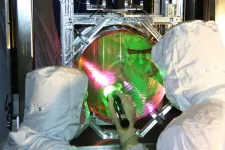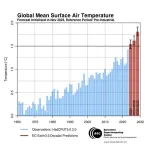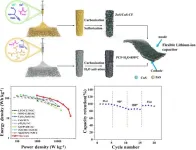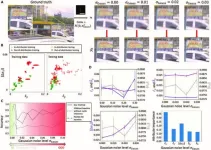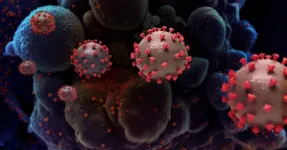(Press-News.org) An experiment outlined by a UCL (University College London)-led team of scientists from the UK and India could test whether relatively large masses have a quantum nature, resolving the question of whether quantum mechanical description works at a much larger scale than that of particles and atoms.
Quantum theory is typically seen as describing nature at the tiniest scales and quantum effects have not been observed in a laboratory for objects more massive than about a quintillionth of a gram, or more precisely 10^(-20)g.
The new experiment, described in a paper published in Physical Review Letters and involving researchers at UCL, the University of Southampton and the Bose Institute in Kolkata, India, could in principle test the quantumness of an object regardless of its mass or energy.
The proposed experiment exploits the principle in quantum mechanics that the act of measurement of an object can change its nature. (The term measurement encompasses any interaction of the object with a probe – for instance, if light shines on it, or if it emits light or heat).
The experiment focuses on a pendulum-like object oscillating like a ball on a string. A light is shone on one half of the area of oscillation, revealing information about the location of the object (i.e., if scattered light is not observed, then it can be concluded that the object is not in that half). A second light is shone, showing the location of the object further along on its swing.
If the object is quantum, the first measurement (the first flash of light) will disturb its path (by measurement induced collapse -- a property inherent to quantum mechanics), changing the likelihood of where it will be at the second flash of light, whereas if it is classical then the act of observation will make no difference. Researchers can then compare scenarios in which they shine a light twice to ones where only the second flash of light occurs to see if there is a difference in the final distributions of the object.
Lead author Dr Debarshi Das (UCL Physics & Astronomy and the Royal Society) said: “A crowd at a football match cannot affect the result of the game simply by staring strongly. But with quantum mechanics, the act of observation or measurement itself changes the system.
“Our proposed experiment can test if an object is classical or quantum by seeing if an act of observation can lead to a change in its motion.”
The proposal, the researchers say, could be implemented with current technologies using nanocrystals or, in principle, even using mirrors at LIGO (Laser Interferometer Gravitational-Wave Observatory) in the United States which have an effective mass of 10kg.
The four LIGO mirrors, which each weigh 40kg but together vibrate as if they were a single 10kg object, have already been cooled to the minimum-energy state (a fraction above absolute zero) that would be required in any experiment seeking to detect quantum behaviour.
Senior author Professor Sougato Bose (UCL Physics & Astronomy) said: “Our scheme has wide conceptual implications. It could test whether relatively large objects have definite properties, i.e., their properties are real, even when we are not measuring them. It could extend the domain of quantum mechanics and probe whether this fundamental theory of nature is valid only at certain scales or if it holds true for larger masses too.
“If we do not encounter a mass limit to quantum mechanics, this makes ever more acute the problem of trying to reconcile quantum theory with reality as we experience it.”
In quantum mechanics, objects do not have definite properties until they are observed or interact with their environment. Prior to observation they do not exist in a definite location but may be in two places at once (a state of superposition). This led to Einstein’s remark: “Is the moon there when no one is looking at it?”
Quantum mechanics may seem at odds with our experience of reality but its insights have helped the development of computers, smartphones, broadband, GPS, and magnetic resonance imaging.
Most physicists believe quantum mechanics holds true at larger scales, but is merely harder to observe due to the isolation required to preserve a quantum state. To detect quantum behaviour in an object, its temperature or vibrations must be reduced to its lowest possible level (its ground state) and it must be in a vacuum so that nearly no atoms are interacting with it. That is because a quantum state will collapse, a process called decoherence, if the object interacts with its environment.
The new proposed experiment is a development of an earlier quantum test devised by Professor Bose and colleagues in 2018. A project to conduct an experiment using this methodology, which will test the quantum nature of a nanocrystal numbering a billion atoms, is already underway, funded by the Engineering and Physical Sciences Research Council (EPSRC) and led by the University of Southampton.
That project already aims for a jump in terms of mass, with previous attempts to test the quantum nature of a macroscopic object limited to hundreds of thousands of atoms. The newly published scheme, meanwhile, could be achieved with current technologies using a nanocrystal with trillions of atoms.
The new paper was co-authored by Dr Das and Professor Bose at UCL along with Professor Dipankar Home of India’s Bose Institute (who also co-authored the 2018 paper) and Professor Hendrik Ulbricht of the University of Southampton.
END
Experiment could test quantum nature of large masses for the first time
An experiment outlined by a UCL-led team could test whether relatively large masses have a quantum nature, resolving the question of whether quantum mechanical description works at a much larger scale than that of particles and atoms.
2024-01-16
ELSE PRESS RELEASES FROM THIS DATE:
Ten scientists receive EMBO Installation Grants
2024-01-16
16 January 2024 – EMBO is pleased to announce that ten life scientists have been awarded EMBO Installation Grants, which support group leaders who will move to, or have recently moved to, countries participating in the scheme. The scientists’ inspiring research spans a wide range of biological processes: ageing, tumour biology, gut-brain axis communication, microbiota and gene editing tools are among the topics they are exploring.
One installation grantee will establish a laboratory in the Czech Republic, one in Greece, two in Hungary, ...
Dual-metal sulfides improve overall function of anode material in lithium-ion capacitors
2024-01-16
The use of dual metal sulfides, specifically ZnS/CuS, shows marked improvement in electrochemical stability and performance when included in the design of flexible lithium-ion capacitors over the use of transition metal sulfides and carbon fiber materials.
Technology is becoming more and more integrated with daily life, especially wearable, flexible tech and smart devices. Transition metal sulfide (TMS) materials are popular among choices for anodes in developing flexible lithium-ion capacitors ...
New method for addressing the reliability challenges of neural networks in inverse imaging problems
2024-01-16
Uncertainty estimation is critical to improving the reliability of deep neural networks. A research team led by Aydogan Ozcan at the University of California, Los Angeles, has introduced an uncertainty quantification method that uses cycle consistency to enhance the reliability of deep neural networks in solving inverse imaging problems.
This research was published Dec. 21 in Intelligent Computing, a Science Partner Journal.
Deep neural networks have been used to solve inverse imaging problems, such as image denoising, ...
Aston University receives £10m from Research England to establish the Aston Institute for Membrane Excellence
2024-01-16
The Aston Institute for Membrane Excellence (AIME) will be set up with a £10m grant from Research England
AIME will be led by Professor Roslyn Bill from Biosciences and Professor Paul Topham from Chemical Engineering and Applied Chemistry
The globally unique institute will use biomimetic polymer membranes for applications such as water purification and drug development
Aston University will establish the Aston Institute for Membrane Excellence (AIME), a globally unique, cross-disciplinary institute to develop novel biomimetic membranes, after receiving a major grant of £10m from Research England.
AIME will be led by Professor Roslyn Bill, from the School ...
Innovative COVID-19 analysis supports prevention protocols in health care settings
2024-01-16
In early 2020, severe acute respiratory syndrome coronavirus 2 (SARS-CoV-2), a highly contagious and pathogenic virus, made its alarming debut and quickly spread worldwide, causing the novel coronavirus (COVID-19) pandemic that threatened human health and public safety. While the world was brought to a standstill, hospitals and health care systems entered unchartered territory and quickly adapted to the evolving health crisis to care for their community and keep potentially sick patients and health care workers from spreading the virus.
The magnitude of response involved the reinforced universal masking of health care ...
New study mapping entire genome of oral stem cells opens new doors for regenerative medicine
2024-01-16
Cambridge, Mass., Jan. 16, 2024 - A team of researchers from the ADA Forsyth Institute and University of North Carolina (UNC), Chapel Hill used single-cell transcriptomic analysis to successfully map dental pulp stem cells (DPSC) and periodontal ligament stem cells (PDLSC) and found remarkable differences between them. The study, which appeared in the Journal of Dental Research, provides the most detailed analysis of these stem cells to date, identifying the entire genome of the stem cells and their potential differentiation trajectories.
“Dental pulp and periodontal ligament stem cells both have the potential to develop into any type of cell in the body,” ...
Do violent video games numb us towards real violence?
2024-01-16
Neuroscientists from the University of Vienna and the Karolinska Institute in Stockholm have investigated whether playing violent video games leads to a reduction in human empathy. To do this, they had adult test subjects play a violent video game repeatedly over the course of an experiment lasting several weeks. Before and after, their empathic responses to the pain of another person were measured. It was found that the violent video game had no discernible effect on empathy and underlying brain activity. These results have now been published in the renowned journal eLife.
Video games have become an integral part of the everyday life of many ...
Novel AI platform matches cardiologists in detecting rheumatic heart disease
2024-01-16
WASHINGTON (Jan. 16, 2024) – Artificial intelligence (AI) has the potential to detect rheumatic heart disease (RHD) with the same accuracy as a cardiologist, according to new research demonstrating how sophisticated deep learning technology can be applied to this disease of inequity. The work could prevent hundreds of thousands of unnecessary deaths around the world annually.
Developed at Children’s National Hospital and detailed in the latest edition of the Journal of the American Heart Association, the new AI system combines the power of novel ultrasound probes with portable electronic ...
Researchers examine accuracy of adult body weight estimates in the emergency department
2024-01-16
Knowing a patient’s weight is necessary for many weight-based medications such as thrombolytics, anticoagulants and numerous cardiovascular medications. Scaling drugs to a patient’s weight prevents adverse events from overtreatment and treatment failure due to underdosing. Inaccurate weight estimations may lead to inaccurate drug doses, which could cause patient harm.
However, in the emergency department (ED) during resuscitative care, measuring weight is often impossible. Moreover, little is known about the relative accuracy of different methods currently used to weigh patients during emergency care. For example, ...
Conscience announces first success in open science challenge to predict “hits” for Parkinson’s disease drugs
2024-01-16
TORONTO (16 January 2024) – As part of its pioneering approach to drug discovery, the Canadian nonprofit Conscience announced today that its first open science competition has resulted in the identification of seven promising molecules, or “hits,” that show potential for new, more effective drugs for familial Parkinson’s disease.
This first competition in Conscience’s CACHE (Critical Assessment of Computational Hit-Finding Experiments) Challenge series was funded by The ...
LAST 30 PRESS RELEASES:
Crystallographic engineering enables fast low‑temperature ion transport of TiNb2O7 for cold‑region lithium‑ion batteries
Ultrafast sulfur redox dynamics enabled by a PPy@N‑TiO2 Z‑scheme heterojunction photoelectrode for photo‑assisted lithium–sulfur batteries
Optimized biochar use could cut China’s cropland nitrous oxide emissions by up to half
Neural progesterone receptors link ovulation and sexual receptivity in medaka
A new Japanese study investigates how tariff policies influence long-run economic growth
Mental trauma succeeds 1 in 7 dog related injuries, claims data suggest
Breastfeeding may lower mums’ later life depression/anxiety risks for up to 10 years after pregnancy
Study finds more than a quarter of adults worldwide could benefit from GLP-1 medications for weight loss
Hobbies don’t just improve personal lives, they can boost workplace creativity too
Study shows federal safety metric inappropriately penalizes hospitals for lifesaving stroke procedures
Improving sleep isn’t enough: researchers highlight daytime function as key to assessing insomnia treatments
Rice Brain Institute awards first seed grants to jump-start collaborative brain health research
Personalizing cancer treatments significantly improve outcome success
UW researchers analyzed which anthologized writers and books get checked out the most from Seattle Public Library
Study finds food waste compost less effective than potting mix alone
UCLA receives $7.3 million for wide-ranging cannabis research
Why this little-known birth control option deserves more attention
Johns Hopkins-led team creates first map of nerve circuitry in bone, identifies key signals for bone repair
UC Irvine astronomers spot largest known stream of super-heated gas in the universe
Research shows how immune system reacts to pig kidney transplants in living patients
Dark stars could help solve three pressing puzzles of the high-redshift universe
Manganese gets its moment as a potential fuel cell catalyst
“Gifted word learner” dogs can pick up new words by overhearing their owners’ talk
More data, more sharing can help avoid misinterpreting “smoking gun” signals in topological physics
An illegal fentanyl supply shock may have contributed to a dramatic decline in deaths
Some dogs can learn new words by eavesdropping on their owners
Scientists trace facial gestures back to their source. before a smile appears, the brain has already decided
Is “Smoking Gun” evidence enough to prove scientific discovery?
Scientists find microbes enhance the benefits of trees by removing greenhouse gases
KAIST-Yonsei team identifies origin cells for malignant brain tumor common in young adults
[Press-News.org] Experiment could test quantum nature of large masses for the first timeAn experiment outlined by a UCL-led team could test whether relatively large masses have a quantum nature, resolving the question of whether quantum mechanical description works at a much larger scale than that of particles and atoms.
